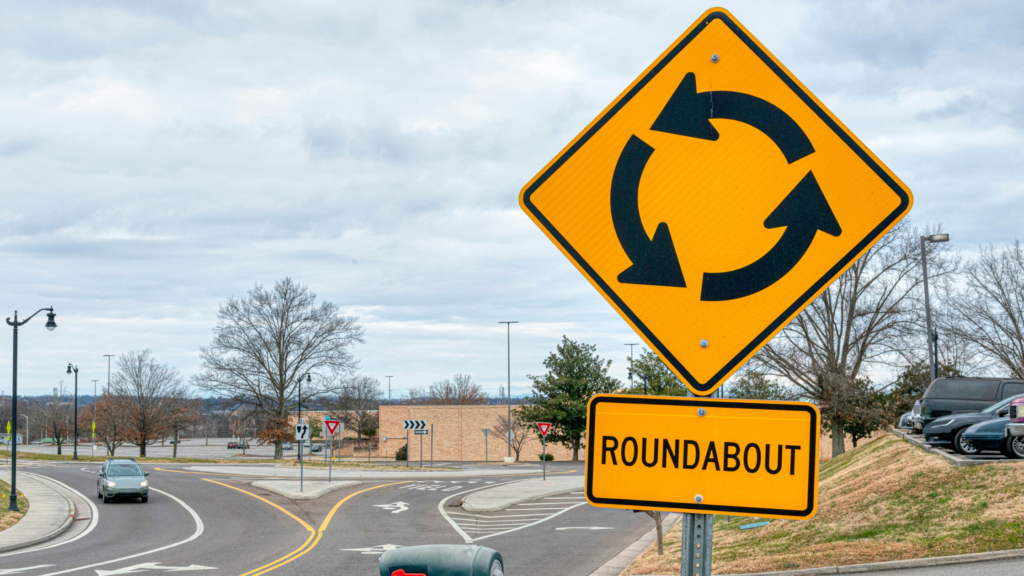- News
- Michigan Roundabouts: How to Safely Navigate Those Confusing Traffic Circles
Michigan Roundabouts: How to Safely Navigate Those Confusing Traffic Circles

Roundabouts, also known as rotaries or traffic circles are designed to improve traffic flow, reduce fuel consumption, and boost quality of driving for motorists. In most cases they work as intended. But they can occasionally cause surprising problems, including some traffic-snarling accidents. Let’s talk about roundabouts… their defining characteristics, their potential value, and the possible risks they pose to Michigan drivers.
What Exactly Is a Roundabout?
In general, how we refer to these traffic control systems depends largely upon their size:
- Traffic circles are usually found at smaller, low-flow intersections which were formerly ruled by stop signs. They typically involve a single lane in each direction and have yield signs at all four incoming streets.
- Roundabouts generally contain more than one driving lane and are significantly larger than traffic circles. They share the same yield sign standard operating procedure for drivers to ensure safer traffic flow (more on that in a bit).
- Rotaries are the mothers of all circular traffic flow systems. Some have five or more different roads entering their circular traffic flow and can be considered terrifying “mixing bowls” for cars, trucks, motorcycles, or even bicycles. Today, there are a number of notable rotaries in Michigan, but among the largest nationwide are several massive rotaries in Cape Cod, Massachusetts, where, coincidentally, the very first rotary was installed. Perhaps one of the world’s best-known rotaries is Columbus Circle, in Manhattan. It’s “ground zero” for navigation distance whenever you’re traveling to New York City.
Why Are Various Traffic Circles Becoming so Popular?
Your high school geometry teacher made it clear: The shortest distance between two points is a straight line. But it might not be the safest. Sometimes driving in a roundabout fashion can be far quicker and much less hazardous! At least that’s what traffic engineers are hoping to accomplish as they install more traffic circles across the state.
First off, consider the force of impact when a car runs a red light at a typical intersection and T-bones another vehicle. Accidents of this type are some of the most dangerous of all due to the extreme kinetic energy of the collision that occurs between fast-moving vehicles. By significantly cutting vehicle speeds at intersecting roads, roundabouts reduce the possibility of direct impacts and therefore result in less severe injuries to passengers and drivers alike if there ever is an accident.
Additionally, according to the Insurance Institute for Highway Safety (IIHS), roundabouts also cut travel time by reducing traffic delays — not to mention saving fuel that would otherwise be wasted while sitting at red lights. The IIHS credits roundabouts for improved pedestrian safety, too.
What’s the Status of Roundabouts in Michigan?
Michigan has long been known for innovative travel improvements, starting with the first stretch of paved road in the world – Woodward Avenue – and continuing with the infamous (yet highly effective) “Michigan left.” Roundabouts are yet another traffic control innovation that the state appears to be installing wherever space permits and MDOT’s budget allows. And, while some drivers detest them, roundabouts do seem to be helping drivers save time spent in the car – not to mention precious human lives and gasoline – by eliminating the need to step on the brakes and wait impatiently for a green light.
Indeed, the Michigan Department of Transportation is sold on the idea of using roundabouts for many other reasons, including the elimination of costly traffic control lights, energy preservation, and less frequent maintenance. What’s more, if there’s ever a power outage, roundabouts continue to function (unlike electric traffic signals). An informative brochure published by MDOT explains why you’ll be seeing even more traffic circles in the coming years and provides tips for safely navigating them.
Are Traffic Circles Really Safer?
They are — and statistics prove it! One study conducted by the Insurance Institute for Highway Safety reported that a 90 percent drop in serious injury/fatality accidents could be attributed to the use of these circular traffic flow designs. We think you’ll agree that’s a significant, improvement and well worth the investment being made in them. However, roundabouts can sometimes lead to multi-car collisions due to the larger number of vehicles that can simultaneously occupy the same space. Hardly a week goes by without us hearing about an accident at one of the multiple roundabouts that have popped up in metro Detroit. Among the worst are those at the following locations:
- Van Dyke north of 18 Mile Road in Sterling Heights
- Orchard Lake Road and 14 Mile Road in Farmington Hills
- Pontiac Trail and M-5 in Commerce Township
Of course, staying safe in a roundabout requires drivers to be alert and yield to others – something folks seem to have issues with every once in a while! The most basic roundabout rule is that you must yield the right of way to traffic already in the circle, take your turn (something you likely learned in kindergarten), and enter the flow of traffic only after you’ve determined it’s safe to do so.
Involved in a Roundabout Accident? We’ll Be Straight with You.
While we’re generally convinced that roundabouts, traffic circles, and rotaries are safer, improve traffic flow, and save fuel, we still know that they can lead to driver confusion and accidents or injuries. If you or someone you love is involved in a roundabout collision – or really any type of accident on Michigan’s highways – we’re here to help. Get in touch now by calling us at 855-MIKE-WINS (855-645-3946). We’ll be there straight away — because there’s nothing roundabout in the way we deal with helping accident victims!

Content checked by Mike Morse, personal injury attorney with Mike Morse Injury Law Firm. Mike Morse is the founder of Mike Morse Law Firm, the largest personal injury law firm in Michigan. Since being founded in 1995, Mike Morse Law Firm has grown to over 200 employees, served 40,000 clients, and collected more than $1.5 billion for victims of auto, truck and motorcycle accidents. The main office is in Southfield, MI but you can also find us in Detroit, Sterling Heights and many other locations.








